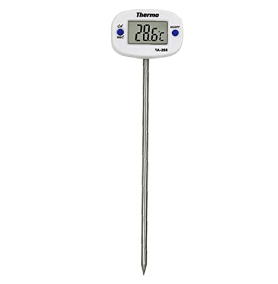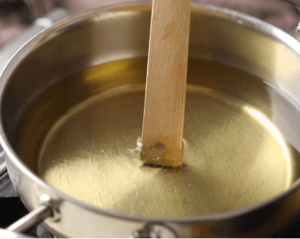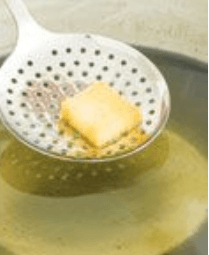How Do You Measure The Temperature of Cooking Oil?

Do you want to cook a perfect dish for your family or for your start-up fast-food stall or restaurant? No matter what type of cuisine you want to cook, They all have a few meals that call for frying. It all begins in a similar way, whether it’s seafood, meat, pastries, or veggies. As an illustration, they begin with a pan of oil that is heating up. It’s simple to put oil in a pan and start cooking, but how do you measure the temperature of cooking oil?

When cooking with oil, it is important to know the temperature of the oil. It’s undoubtedly simpler if you’ve got a kitchen thermometer, but you can nevertheless succeed without one. Your food will be cooked accurately and properly thanks to this. You can gauge the temperature of frying oil in a few different ways.
A candy thermometer is one method. Use of an instant-read thermometer is another option. Finally, you can also estimate the temperature of the oil by its color.
How do you measure the temperature of cooking oil?
If you’re cooking with oil, it’s important to know what temperature the oil is. If the oil is too hot, it can ruin the dish that you are cooking. If the oil is not hot enough, it will not cook the food properly. Here are a few ways to test your cooking oil temperature:
- Use a candy or deep fry thermometer. Insert the thermometer into the oil and make sure that it does not touch the sides or bottom of the pan. Wait for a few minutes for it to register the correct temperature.
- Another way to test the temperature of your oil is to sprinkle a little bit of flour into the pan.
 Then watch to see how quickly it browns. The flour should start to brown within 15-20 seconds if the oil is ready to use. Be sure to keep an eye on the thermometer or flour so that you can adjust as needed throughout cooking.
Then watch to see how quickly it browns. The flour should start to brown within 15-20 seconds if the oil is ready to use. Be sure to keep an eye on the thermometer or flour so that you can adjust as needed throughout cooking. - Use an infrared thermometer. This is the most accurate way to measure the temperature of your oil.
- Do a “flick test.” Splash a little bit of water into the hot oil. If it immediately forms into tiny balls and sizzles, that means your oil is between 375 and 400 degrees Fahrenheit.
How to Tell If Oil is 350 Degrees Without a Thermometer
Have you ever attempted a dish that required you to heat the oil to a temperature of 350°F or 370°F & wondered how you would know when the oil was hot enough to fry without using a deep-frying thermometer?
Well, I have, for sure.

The typical deep-frying temperature range is 360°F to 375°F. Oil that’s too hot can ruin your dish, and oil that’s not hot enough won’t give you the desired results. Here are three methods for checking the readiness of frying oil without the use of an oil-safe thermometer. When the oil hits this temperature range, these methods aim to notify the person using it.
Method –1: Flick a drop of water into the pan. If it sizzles and evaporates immediately, the oil is ready.
Avoid this method or be careful with this method, otherwise you can get a nasty burn.
Method -2: Place a wooden spoon in the pan. If the wood starts to smoke, the oil is ready.
Method-3: Drop in a piece of bread.
If it browns quickly and floats to the top, the oil is 350 degrees.
Cooking Oil Temperature Celsius:
The internal temperature at which cooking oil starts to continuously emit bubbles and smoke is known as the smoke point. The type of oil determines the smoke point. For instance, canola oil has a higher smoke point than olive oil.
It’s crucial to monitor the temperature when cooking using oil. The oil may begin to smoke and degrade if it heats up too much. This not only affects the taste of your food but also has the potential to emit dangerous substances into the atmosphere.
Here’s a helpful guide on the ideal cooking temperature for different types of oils:
Olive oil: 160-190 degrees Celsius
Canola oil: 190-200 degrees Celsius
Vegetable oil: 160-180 degrees Celsius
How to Tell When Oil is Hot Enough to Fry?

If you’re anything like me, you love fried foods. Whether it’s chicken, fish, french fries, or onion rings, there’s just something about that crispy exterior and hot, juicy interior that makes my mouth water. But one of the most important things to remember when frying foods is to make sure your oil is hot enough.
If it’s not, your food will be greasy and soggy instead of crisp and golden brown. So how can you tell when your oil is hot enough?
There are a few different ways to test the temperature of your oil:
- Use a cooking thermometer – This is the most accurate way to test the temperature of your oil. Simply insert the thermometer into the oil and wait for it to show the correct temperature. Depending on what you’re frying, the ideal temperature range is usually between 350-375 degrees Fahrenheit.
- Drop in a piece of bread – Another way to test the temperature of your oil is to drop in a piece of bread or other food item. If the bread begins to fry immediately and turns golden brown within 60 seconds, then your oil is ready to go. If it takes longer than that or if the bread doesn’t brown evenly, then your oil isn’t quite hot enough yet.
- Drop a tiny sized batter/dough in the heated oil– If you drop a tiny bit of your batter, mixture, dough, or other frying ingredient into heated oil and watch it instantly sizzle to the surface, your oil is hot enough. Reduce the heat or switch off the burner for two to three minutes to allow the oil to cool, if it sizzles up and browns promptly. Then check again.
- Look for ripples on the surface – Another visual cue that your oil is ready is when you see ripples appearing on its surface . This means that it’s starting to get hot enough to fry whatever you put in it!
How to Heat Oil to 375 Degree Without Thermometer
If you’re looking to heat oil without using a thermometer, there are a few methods you can use. One is to heat the oil in a pot or pan on the stove over medium-high heat. Once the oil starts to shimmer and smoke, it’s typically around 375 degrees Fahrenheit.
Another method is to fill a large pot or Dutch oven with oil and then place it in an oven preheated to 400 degrees Fahrenheit; after 30 minutes, the oil should be ready. Finally, if you have an electric deep fryer, you can set it to 375 degrees Fahrenheit and wait for the indicator light to turn off, at which point the oil will be heated and ready for use. Whichever method you choose, be cautious when working with hot oil.
Oil Frying Temperature Celsius
Fryer oil temperature is one of the most important factors in fryer performance. If the oil is too cold, food will absorb too much oil and be greasy. Similarly, if the oil is too hot, food will not cook properly.
The ideal frying temperature for most foods is between 325 and 375 degrees Fahrenheit (163 and 190 degrees Celsius). Many factors can affect fryer oil temperature, including the type of food being fried, the size and shape of the food, the amount of oil in the fryer, and ambient air temperature. A good rule of thumb is to start with your fryer set at 375 degrees Fahrenheit (190 degrees Celsius) and then adjust as needed based on your frying results.
If you find that your food is coming out greasy, try reducing the fryer temperature by 10 or 15 degrees Fahrenheit (5 or 8 degrees Celsius). Increase the fryer temperature by a similar amount in case your food isn’t cooking properly. Remember to give yourself time to adjust to any changes in frying temperature; it may take a few batches of food before you get everything just right!
What is the Ideal Oil Temperature When Cooking?
For frying, an oil temperature of between 365°F and 375°F is advised.
Also keep in mind that the smoke points of various cooking oils vary. The smoke point of light olive oil, which is typically used for baking and cooking, is 468 °F. The smoking point of extra virgin olive oil is lower, at 410 F.
The smoking point of avocado oil, a common ingredient in baking and salad dressings, is 520 degrees Fahrenheit. The smoking point of almond oil, a common ingredient in salad dressings and a strong source of vitamin E, is 430 degrees Fahrenheit. The boiling points of butter, canola, and coconut oils are 350°F, 400°F, and 350°F, respectively.
Can I Use a Meat Thermometer to Measure Oil Temp?

No, you cannot use a meat thermometer to measure oil temperature. Oil and water have different densities, so the thermal expansion of oil is different from that of water. That means that the volume of oil increases or decreases by a different amount than water when heated or cooled.
So, a meat thermometer placed in oil would not give an accurate reading.
What Would You Use to Measure the Temperature of Oil for Deep Frying?
If you’re deep frying, you’ll want to use a cooking thermometer to measure the temperature of your oil.
There are two types of cooking thermometers: instant-read and leave-in. Instant-read thermometers are inserted into the food to get a quick reading, while leave-in thermometers stay in the food during cooking.
For deep frying, you’ll want an instant-read or leave-in probe thermometer. Probe thermometers have a metal tip that goes into the food, allowing you to get an accurate reading of the internal temperature.
When choosing a probe thermometer, make sure that it can withstand high temperatures; most can measure up to 400 degrees Fahrenheit (200 degrees Celsius).
Tips:
Here are some things to keep in mind when using a cooking thermometer:
-Insert the tip of the thermometer into the thickest part of the food, away from any bone or fat. You will get the most accurate reading.
-Don’t let the tip of the thermometer touch the bottom or sides of the pan, as this could give you a false reading.
-Stir the food occasionally while taking readings so that you get an accurate average temperature.
Conclusion
If you’re interested in cooking with oil, you might be wondering “how do you measure the temperature of cooking oil?” While there are various additional methods to do this, using a kitchen thermometer is the most accurate way. Simply place a cooking thermometer into the oil and wait for the temperature reading to stabilize to start cooking.
Remove the thermometer when the temperature reaches the desired level, then continue with the preparation. It’s vital to avoid exceeding your desired temperature too much because the oil will continue to cook even after you take it off the heat.
Read more about-

 Then watch to see how quickly it browns. The flour should start to brown within 15-20 seconds if the oil is ready to use. Be sure to keep an eye on the thermometer or flour so that you can adjust as needed throughout cooking.
Then watch to see how quickly it browns. The flour should start to brown within 15-20 seconds if the oil is ready to use. Be sure to keep an eye on the thermometer or flour so that you can adjust as needed throughout cooking.

Comments(0)